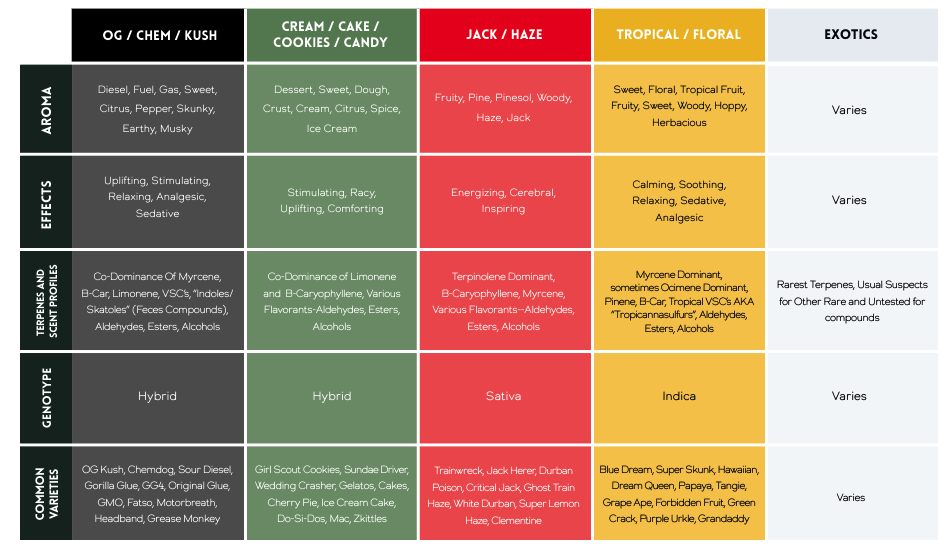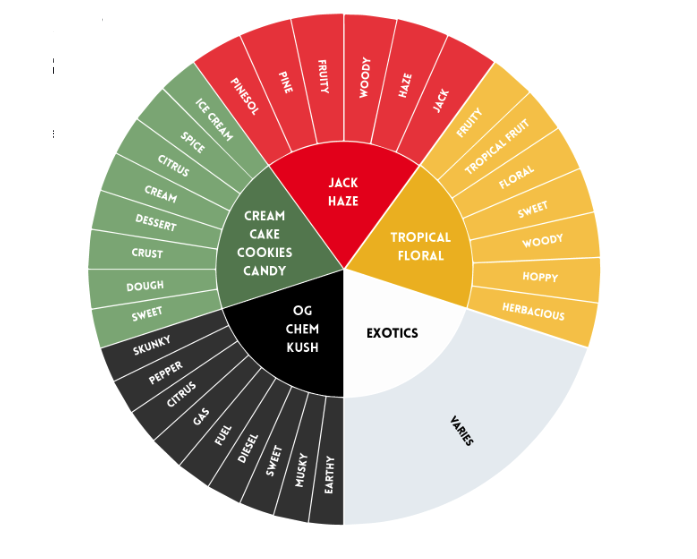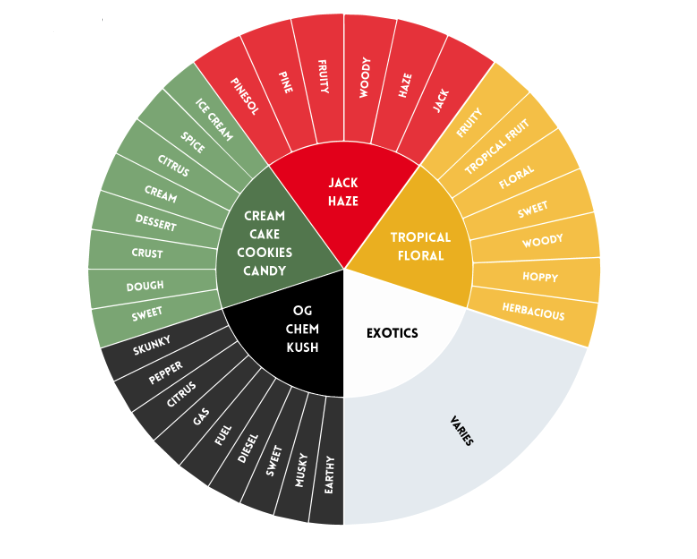Understanding and Categorizing Cannabis Varieties by aromas, terpenes, smell compounds, and genetic lineage
Introduction
Cannabis aroma families are an Atlas Seed framework that we’ve built in an attempt to understand our own growing and breeding work better, as well as conveying to customers the information they need to know to find what they want to grow. Our cannabis flavor wheel helps categorize these aromas, making it easier to identify and select strains based on their unique profiles.
We’ve modeled our framework after the work SC Labs and Emerald Cup did to define terpene classes, as well as looking at research from Abtrax Tech regarding flavorants, which are essentially non-terpene based smell compounds, in addition to numerous other articles, conversations, and white board sessions. Of course their work like ours is foundationally built upon understanding the building blocks of existing cannabis lineages over the last 50 years of contemporary cultivar development, specifically in the Type-1, THC dominant, recreational and medicinal varieties.
Categorizing Cannabis Aromas: A Simple Yet Effective Approach
The most straightforward way to describe the smell of a plant is to just tell it like it is: apples and chamomile; sandalwood and blueberries; pineapple and lighter fluid, etc. But humans being as we are like to make sense of things through categorization, and thus organizing systems of all sorts come into play. The system we’ve iterated broadly speaking is very simple: If a variety smells like a thing, then it goes in a category that reflects that thing, provided that the available categories are clear enough to contain the thing you’re trying to categorize!
Gassy, skunky, funky, chemical, and various types of wacky weed smells go in the OG category. Mango and papaya and pineapple and guava weed in the tropical category. Throw the cakes in with all the other desserts. If it’s jack, with its characteristic piney scent, put it with the jacks and hazes. Exotics, as in the case of the SC Labs system, we’ve earmarked for strains that have dominant rare terpenes.
Understanding Terpene Classifications in Cannabis
The brilliance of the SC Labs terpene class system is it begins to really make sense of what terpenes are offering in modern cannabis cultivars, and in many cases the terpenes do line up really nicely with the broader categories they’ve named. But we felt as much as it highlights unique terpene contributions, especially when they truly are unique, as in the case of anything that’s not part of the ever dominant mafia of myrcene, b-caryophyllene, and limonene; it demonstrates just how much other compounds that we don’t currently know about or test for in commercial lab settings are contributing to the overall aroma of a plant.
To highlight this point, while reviewing our own internal information, purple punch stood out for us as a very tropical smelling variety, but if you were to classify by terpene classes it goes with the desserts since it’s generally b-caryophyllene and limonene dominant. It likely smells tropical due to some presence of “tropicannasulfurs”, which are sulfur based compounds that have a seem to have tropical smell to them; or some other compounds possibly even presenting in the parts per trillion that we don’t or can’t currently test for in a convention cannabis lab setting. Therefore, in this case we chose to classify it based on its sensory / olfactory presentation in aroma terms rather than put it in a category based solely on the terpenes we were seeing in lab results.
Side Note
As a side note, we also thought the Sweets and Dreams category was confusing, and since the Tropical/Floral and Sweets and Dreams terpene classes were both generally Myrcene dominant, we combined the two categories. We also renamed Desserts as Creams / Cookies / Cakes / Candies; and the OG / Gas category we’re calling OG / Chem / Kush.
What follows is our take on what we’re calling “Aroma Families”

The Aroma Families
OG / Chem / Kush
Aromas
Diesel, fuel, gas, sweet, citrus, skunky, earthy, musky
Description
This aroma family is foundationally based on crosses between chem and kush lines that established the iconic smell realm that we now think of most commonly and colloquially as GAS. It is classically a myrcene, limonene, and b-caryophyllene co-dominant aroma family, though we believe that some of the more pronounced smells of this category are coming from untested for volatile sulfur compounds and other mysterious what have you’s.
Volatile sulfur compounds are not currently being tested for in market ready cannabis labs but have been identified as being active contributors to particularly pungent smells in cannabis aromatics, as well as a number of other commonly aromatically pronounced foods such as garlic, durian, and hops.
In terms of terpenes, we’ve read that Limonene is the least identifiable and reliable terpene in determining the end result smell of a variety. We’ve seen examples to the contrary, for instance in our Banjo line, a limonene dominant variety that is indeed extremely citrus forward in the field. At any rate, it is limonene which gives this aroma family an extra energizing boost, and consistent notes of citrus common in gas lines. Myrcene can possibly cross the blood brain barrier which is what can deliver an extra something something and essentially cause these varieties to pack a major knock out punch. Therefore myrcene acts a potent analgesic, and its pain relieving properties may be due to its interactions with the opiate system. B-Caryophyllene is normally noted for its spice notes, and can enhance pain relieving and anti-inflammatory effects.
Hash Production and the Influence of OG/Chem/Kush Lines
Though this aroma family doesn’t tend to test quite as high as the creams / cookies / cakes / candies aroma family in terms of overall THC potency, it is seems on average to have some of the best lines for hash production, so for solventless extraction ie washing strains, OG / Chem / Kush is the way. The most likely reason for this is due to the strong Afghani influence in this aroma family exemplified in the kush lines. After all, it is Afghanistan’s cannabis landrace and hash producing culture that has led the way in hashish output for as far back as anyone can seem to remember. Producing cannabis for smokable flower and artisanal extracts is a very recent and truly American phenomenon!
Effects
Uplifting, stimulating, relaxing, analgesic (pain relieving), sedative
Terpenes and smell compounds
Co-dominance of Myrcene, B-caryophyllene, Limonene, Volatile Sulfur Compounds, “indoles / skatoles” (feces compounds), various flavorants–aldehydes, esters, alcohols.
Common Varieties
OG Kush, Chemdog, Sour Diesel, Gorilla Glue, GG4, Original Glue, GMO, Fatso, Motorbreath, Headband, Grease Monkey, Jet Fuel.
Atlas Varieties
Dirty Laundry, Cheetah Fat, Gopher Glue, Mythic Cheetah, Cheetah the Hut, Laundry Shaman, Kombucha Cream, Pilot Light auto, Turtle Taffy auto, Garlic Jam auto, Grease Gun auto, Face Fat auto. GMO 8 auto, GMO OG auto, Mendo Breath auto
Genotype
Hybrid
Cream / Cake / Cookies / Candy
Aromas
Dessert, candy, fruit, sweet, dough, crust, cream, citrus, spice, ice cream
Description
This is one of the more popular aroma families these days, as there’s just something comforting about growing out cannabis varieties that smell like all of our favorite desserts ever. Who hasn’t smelled a buttery doughy pie crust aroma in a flower and been brought nearly to tears? Eh? Most of the varieties in the Creams / Cookies / Cakes / Candies aroma family are defined by a codominance of limonene and caryophyllene. Varieties in the realm of Ice Cream Cake, Wedding Cake, & Gelato all have more or less equal amounts of limonene and caryophyllene. GSC and Cherry pie are examples of caryophyllene dominant and Berry White, Banana OG, Strawberry Banana are examples of limonene dominance.
In terms of overall highest potency, this aroma family as a general rule leads the way, and for this reason has become the most dominant aroma family in the cannabis industry. Many a boutique grower cultivates nearly all dessert terp strains, no doubt in an attempt to blow out the ceiling of what’s possible in high THC varieties, in addition to melting one’s endocannabinoid system and overall ability to comprehend reality. We like ourselves a Girl Scout cookies or Runtz as much as the next grower, but tend to think the overemphasis on high THC in the industry is misguided, annoying, and potentially even harmful, certainly to creative and medicinal breeding programs, and possibly even to consumer’s health. Whatever your taste, tread lightly in this category if you can’t hold your smoke, so to speak.
Effects
Stimulating, uplifting, comforting
Terpenes and smell compounds
Co-dominance of Limonene and B-caryophyllene, various flavorants–aldehydes, esters, alcohols
Common Varieties
Bubba Kush, Girl Scout Cookies, Sundae Driver, Wedding Crasher, Gelatos, Cakes, Cookies, Cherry Pie, Berry White, Banana OG, Strawberry Banana, Ice Cream Cake, Wedding Cake, Do-si-dos, MAC, Zkittles, Runtz
Atlas Varieties
Do-Si-Dos, Huckleberry Pie, Snow Panda, Blueberry Swirl, the Pandalorian, Cherry Lime Reserve, Banana Cream Sundae, Divorce Cake, Gelato 41, Space Panda, Gummibears auto, Top Gun auto, Wedding Cake auto, Tahoe Cookies auto, Gelato auto, Outer Space Cake
Genotype
Hybrid
Jack / Haze
Aromas
Fruity, pine, pinesol, woody, haze, jack, juicy fruit
Description
Perhaps it’s due to the ubiquitous and obvious loudness of jack terps that this aroma family seems to fall in and out of favor amongst long time Cali growers, or perhaps there’s something to the terpinolene scent that hits the same resistance certain people find with cilantro for reasons that are more instinctual than anything else. At team Atlas, we are huge fans of the jack smell, and though we don’t have a dominant jack catalog, we love encountering it in field walks as either a dominant note or back end base note that seems to amplify the other smell compounds.
Terpinolene is the most identifiable and determinant terpene of all, meaning that if it’s present on an olfactory level, you better believe the COA will back that up, and vice versa. Terpinolene is also found in apples, lilacs, and nutmeg. Of note, Jack Herer was made by crossing Northern Lights #5 with Haze. And the Cookies lines were originally created by crossing Durban Poison with OG Kush and Cherry Kush. Also of note: aroma families are always going to have imperfections, since certain varieties seem to straddle categories.
Would we put Blue Dream in with Jack / Haze category, or Tropical / Floral? Since we think it hits hard with berry mango, we put it squarely in the tropical arena. But it has foundational haze lineage and is an instrumental variety in the experiential / sensual experience of the haze aroma. Sometimes you just have to make a tough choice and stick with it.
Effects
Energizing, cerebral, inspiring
Terpenes and smell compounds
Terpinolene dominant, B-caryophyllene, Myrcene, various flavorants–aldehydes, esters, alcohols
Common Varieties
Trainwreck, Jack Herer, Durban Poison, Critical Jack, Black Jack, Platinum Jack, Ghost Train Haze, White Durban, Super Lemon Haze, Clementine
Atlas Varieties
Crazy Train, Jack Herer auto
Genotype
Sativa
Tropical / Floral
Aroma
Sweet, herbaceous, fruity, woody, hoppy, tropical, tropical fruit
Description
This class has essentially two subgroups: the more common myrcene-dominant varieties, and the ocimene-dominant varieties. Tropical Sleigh Ride or Passion Orange Guava are ocimene dominant. Super Skunk, Pineapple, Green Crack and Dream Queen, are high in myrcene with just a little bit of ocimene. But you smell the ocimene so much because ocimene – if it’s there, even if it’s not the pure primary terpene, even if it’s a secondary or tertiary terpene – the smell is so present that it would naturally group together with ocimene-dominant strains. High myrcene with low everything is Tangie, Forbidden Fruit, Cali O, Agent Orange. High myrcene with a little bit of caryophyllene, that’s all the purples – Granddaddy Purps, Grape Ape. Additionally, high myrcene with a little bit of pinene, that’s like Blue Dream.
Effects
Soothing, calming, sedative, analgesic (pain relieving), relaxing
Terpenes and smell compounds
Myrcene dominant, sometimes Ocimene dominant, pinene, B-caryophyllene, tropical VSC’s aka “tropicannasulfurs”, various flavorants–aldehydes, esters, alcohols
Common Varieties
Super Skunk, Hawaiian, Dream Queen, Papaya, Passion Orange Guava, Green Crack, Pink Lemonade, Tangie, Cherry AK,, Blue Dream, Grape Ape, Panama Red, Sweet tooth, Forbidden Fruit, Agent Orange, Mango Puff, Green Crack, Purps: Purple Urkle, Grandaddy Purps, Purple Punch
Atlas Varieties
Papa Smurf, Banjerine, Blue Dream, Slurpicane, Laundry List, Tropical Cooler, Iced Sangria, Green Apple Candy, Space Station, Sour Cherry Diesel, Purple Punch, Pink Grapefruit, Tricross auto, Froot by the Foot auto, Fog Dog auto, Blue Dream auto, Banjo auto, Papaya Bomb auto
Genotype
Indica
Exotics
Aroma
Who the heck knows really, crazy ass shit. Honestly probably smells just like smatterings of other categories if we’re being honest, honestly.
Description
This class includes the rarest profiles and diverse outliers that don’t fit into the major categories. This includes strains dominant in linalool, a-pinene, b-pinene, or ocimene without myrcene present. Better-known “exotic” cultivars include Strawberry Cough, Sour Carmelo, Juicy Gushy and Laffy Taffy.
Effects
Varies
Terpenes and smell compounds
Rarest terps, not part of myrcene, limonene, b-caryophyllene mafia.
Common Varieties
Varies
Atlas Varieties
Galactic Guava x Laundry List #1; most commonly we see a-Humalene, a-Pinene and b-Pinene as sharing co-dominance with more common terpenes. Right now, we need to conduct more testing on our current library. This will help us understand what we are carrying forth in terms of Exotics as we’ve defined them here.
Genotype
Varies
Conclusion
So that’s our attempt at categorical conventions for aroma families for the current cannabis cultivar world. We’d love to hear your thoughts and feedback on this ever evolving system of categorizing cannabis varieties to make sense of what we’re experiencing. We’re aware of the shaky ground that terms like sativa and indica stand upon, yet they’ve become common parlance in the industry, and are difficult to get rid of. Our cannabis flavor wheel aims to bring clarity to this complexity.
We’ve done our best to conjure novel terminology in the case of semi-full terms when we felt available terms were confusing or non-descriptive. And even though the legacy seed industry has adopted colloquialisms like “fems” to refer to any and all feminized photoperiod seeds, we’ve rejected this in favor of more sensible naming conventions (full term and/or photoperiod seed), possibly at the cost of customer understanding and more sales. Our point here is that we’re doing our best to contribute to the understanding and terminology in this space. With your input, we can continue to grow and evolve with this plant.

Aroma Wheel based on Aroma Families
